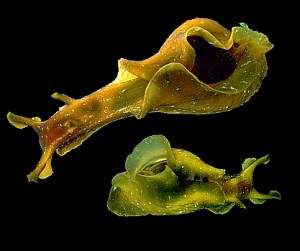
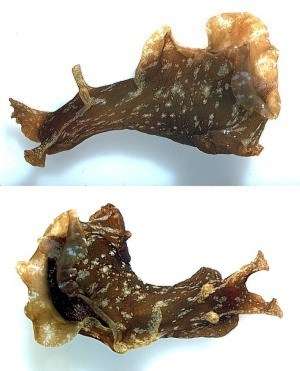
Aplysia juliana
Quoy & Gaimard, 1832
Order: ANASPIDEA
Superfamily: APLYSIOIDEA
Family: Aplysiidae
DISTRIBUTION
Circumglobal - found in all warm water regions of the world.
PHOTO
UPPER: Long Reef, Collaroy, Sydney, NSW, in algal tide pools, ranging in length from 20-45mm. September 1978.
MIDDLE, LOWER: Port Stephens, New South Wales, Australia, 78mm long. October 1980.
PHOTOS: Bill Rudman.
Aplysia juliana is one of the few species of Aplysia that lacks the ink gland which produces the characteristic reddish purple ink. Instead the opaline gland, produces a milky white secretion. All aplysiids have an opaline gland, but the milky white secretion is usually marked by the purple ink. Aplysia juliana is also unusual in that the posterior end of the foot can form a temporary sucker. When the animal crawls along it can use the sucker to anchor itself then greatly extend its head and neck like a leech. Another aplysiid that does this is Dolabrifera dolabrifera.
There are quite a few colour forms of this species which are at present unable to be separated on anatomical grounds. the brownish form with pale spots (top photo) is one of the most common forms, as is one with a uniform black colouration. The other photos here represent a colour form associated with Bergh's Aplysia sibogae, which is considered a synonym.
See the General Topics List for more information on Sea Hares.
Reference:
• Quoy, J.R. & Gaimard, J.P. (1832). Voyage de decouvertes de L'Astrolabe pendant les annees 1826-1827-1828-1829, sous le commandement de M.J. Dumont D'Urville, Zoologie, 2: 1-686.
Rudman, W.B., 1999 (May 3) Aplysia juliana Quoy & Gaimard, 1832. [In] Sea Slug Forum. Australian Museum, Sydney. Available from http://www.seaslugforum.net/find/aplyjuli
Related messages
Sea hares from Tristan da Cunha
June 1, 2010
From: Sue Scott
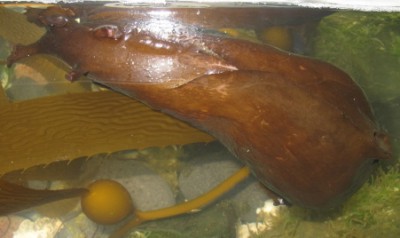
Hello Bill,
More seaslugs from Tristan da Cunha in the South Atlantic - sea hares have just been found by islanders, in shallow rock pools. The animals were up to 160 mm long, and exuded ink. The islanders did not report them swimming, but I will ask. Approx lat/long for the position is 37°05'17.62 S, 12°20'14.90 W. Water temperatures on Tristan vary between 14-20 degrees C.
After trawling through your fact files on sea hare species, the closest I can get is Aplysia brasiliana/ A. fasciata. Pink tinges are visible on the parapodia in one photo. One specimen is plain brown, another has a few cream-coloured spots. The dorsal flaps seem well separated, and roll into a small hole far back near the posterior.
Can you confirm this id, bearing in mind that Tristan is very remote from any other shallow water areas, has many endemics, and describing new species from there is not unusual. This is the first time sea hares have been reported from Tristan to my knowledge - we didn't find any in 5 years of survey work there, although if the populations are very local (i.e.confined to a small stretch of shore (which seems unlikely given their larval dispersal) we might have missed them.Many of Tristan's colonisers by natural means have some from South America and a good proportion also from South Africa, so it would be interesting to know which side of the Atlantic the Tristan specimens originated. However introductions have also occurred through human vectors, most spectacularly when an oil production platform (originating in Brazil) stranded on Tristan in 2006. When we examined the rig we found a huge number of non-native species encrusting the legs, and even some non-native fish that had come across with the rig (and are now well established on Tristan), but no sea hares, and I think it unlikely that they would have survived the stormy crossing.
If there is anyone out there interested in doing genetic work on them, perhaps as part of the A. fasciata/brasiliana debate, I can get a specimen preserved in alcohol for sequencing.
Locality: Flat Rocks, Runaway Beach, Intertidal, Tristan da Cunha, South Atlantic Ocean, May 2010, Intertidal rock pools in fairly extensive rock flats (lava flows), extremely exposed to waves at times. Length: 160 mm. Photographer: Kirsty Green.
Incidentally, a specimen of Anisodoris/Doris fontainei was also found in the rock pools, but thanks to previous correspondence on the seaslug form, was identified immediately!
Best regards,
Sue
suescott153@btinternet.com
Scott, S., 2010 (Jun 1) Sea hares from Tristan da Cunha. [Message in] Sea Slug Forum. Australian Museum, Sydney. Available from http://www.seaslugforum.net/find/23706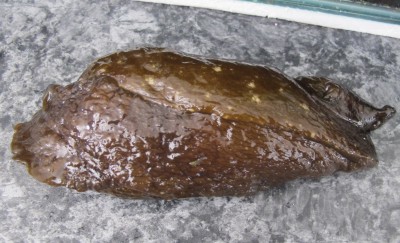
Dear Sue,
Looking at these photos, I am pretty sure this is one of the species in which the parapodia join posteriorly, the 'join' forming quite a high wall partially enclosing the mantle cavity. Yu will see in the lower photo how the exhalent siphon seems to be poking out posteriorly, over a wall. These species dont really swim, and more importantly don't produce a purple ink - although they do produce a viscous white ink. If you could check with the collectors about the colour of the ink they observed it would be useful.
There is the quite feasible possibility that you have more than one species of Sea Hare occurring together - and inker and a non-inker.
Ignoring the inking, my feeling is that this is Aplysia juliana which is widespread throughout the world. Interestingly Eales in her 1960 revision of the world species described a new species of Aplysia from two preserved animals from Tristan da Cunha. She named in Aplysia dura. From her anatomical description it certainly appears to be A. juliana, and her description of the mantle cavity anatomy certainly suggests it does not produce purple ink.
If the local residents do say they saw purple or red ink then my first suggestion is to check if there is more than one species present. You will see from your photos that when the animals are 'sitting' the posterior part off the foot is enlarged and rounded into a sucker. This is very characteristic of A. juliana and others of this non inking group. Inking species usually have the parapodia separate posteriorly and have a more tapering 'tail'.
- Eales, N. B. (1960). Revision of the world species of Aplysia (Gastropoda, Opisthobranchia). Bulletin of the British Museum (Natural History), Zoology, 5(10): 267-404.
Best wishes,
Bill Rudman
Aplysia juliana? from Reunion Island
January 31, 2007
From: Philibert Bidgrain
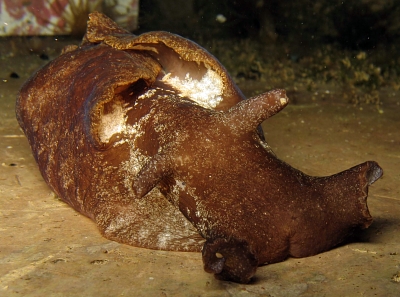
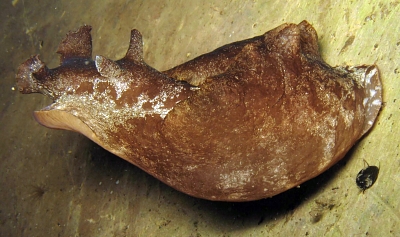
Dear Bill,
I have found two specimens of this species (size 100-120 mm) It looks like A. juliana. But identification of Aplysia seems to be very difficult, so ...What's the main characteristic of A juliana?
Locality: Saint Leu, 50 cm, Reunion Island, Indian Ocean, December 2006. Length: 10 cm. Photographer: Philibert Bidgrain.
What's your opinion about this identification?
Philibert Bidgrain
pbidgrain@yahoo.fr
http://vieoceane.free.fr/runseaslug/indexslug.htm
pbidgrain@yahoo.fr
Bidgrain, P., 2007 (Jan 31) Aplysia juliana? from Reunion Island. [Message in] Sea Slug Forum. Australian Museum, Sydney. Available from http://www.seaslugforum.net/find/19303Dear Philibert,
Aplysia juliana is said to grow to 300 mm in length and is very variable in colour. The parapodia join very high up posteriorly. One very distinctive behavioural feature is that the posterior end of the foot forms a sticky 'sucker' which is used in the peculiar 'looping' form of crawling that this species exhibits. Rather than the smooth crawling found in most species of Aplysia, in A. juliana the posterior end of the foot forms a broad sucker which attaches to a surface and then the rest of the body stretches forward, the front then attaches and the posterior part is drawn forward. The form of locomotion, the lack of a purple gland and the parapodia joining high in the posterior midline are constant characters of this species.
I am not sure what this species is, but it doesn't look like A. juliana to me, and the parapodia seem to join low down posteriorly.
Best wishes,
Bill Rudman
Re: Aplysia juliana in my aquarium
May 25, 2006
From: Michelle Yerman
Concerning message #16616:
Hi Bill,
yes, they were constantly eating Ulva!
Sincerely
Michelle
michelley@austmus.gov.au
Yerman, M., 2006 (May 25) Re: Aplysia juliana in my aquarium. [Message in] Sea Slug Forum. Australian Museum, Sydney. Available from http://www.seaslugforum.net/find/16692Thanks Michelle,
Bill Rudman
Aplysia juliana in my aquarium
May 19, 2006
From: Michelle Yerman
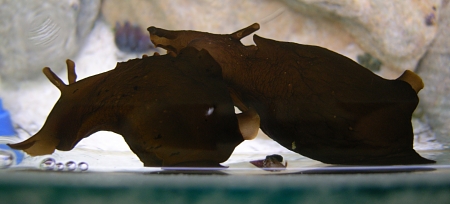
Hi Bill,
I'm sending you some information about my Aplysia juliana that you kindly identified for me. I collected it in early March when it was approximately 1.5 cm long. Two and a half months later it is 13 cm long! On the 28th of April it mated with the other hare in the tank and laid eggs on the 2nd of May. Over this past weekend (13-14 May) it has laid another mass of eggs! I have attached some photos.
From: Maroubra pool, Maroubra, on rock platform, New South Wales, Pacific Ocean. March 2006. Photographer: Michelle Yerman.
Thanks again Bill.
Sincerely
Michelle
michelleyerman@crustacea.net
Yerman, M.N., 2006 (May 19) Aplysia juliana in my aquarium. [Message in] Sea Slug Forum. Australian Museum, Sydney. Available from http://www.seaslugforum.net/find/16616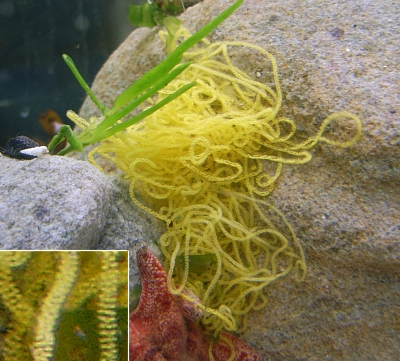
Dear Michelle,
It's nice to get some information on growth rates like this to match with the population based growth rates which are the normal way to measure growth in these animals. I can't remember if I asked before, but I assume you are mainly feeding your Aplysia with Ulva?
Best wishes,
Bill Rudman
Aplysia juliana eaten by Flatworm
April 10, 2006
From: Lisa Kirkendale
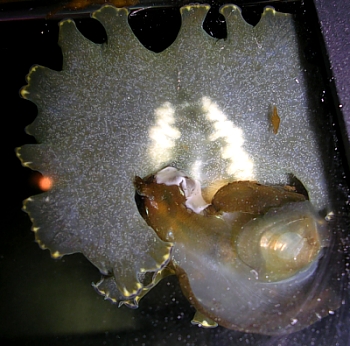
Hi Bill,
I thought you would be interested in these aqarium observations of a flatworm which ate an Aplysia in our aquarium recently. It fortunately did it on the side of the tank so I was able to take these photos through the glass. Following the Aplysia sp., the flatworm then proceeded to eat a specimen of Chelidonura inornata (unfortunately I didn't get any good pictures of that). The animals were all collected locally around Sydney [NSW, Australia].
A friend of mine, Raphael Ritson-Williams has tentatively identified the flatworm as Paraplanocera oligoglena. We were both grad students at the University of Guam Marine Lab, and he has recently published on a flatworm in Guam which harbours the neurotoxin, tetrodotoxin. The planocerid he was looking at ate a variety of marine snails from at least 11 families, and also a species of Elysia.
-
Ritson-Williams, R., Yotsu-Yamashita, M. & Paul, V.J. (2006) Ecological functions of tetrodotoxin in a deadly polyclad flatworm. Proceedings of the National Academy of Sciences (PNAS), 103(9): 3176-3179.
Sincerely,
Lisa Kirkendale
fragum4ever@yahoo.com
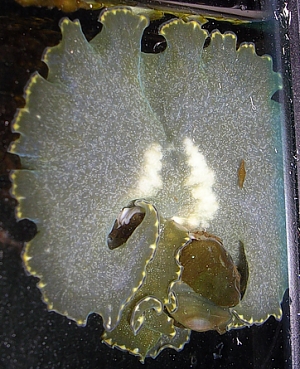
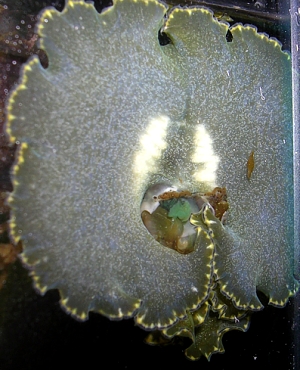
Thanks Lisa,
This is an interesting observation. Its common knowledge that flatworms are carnivorous but actually catching them in the act is not that easy. Its certainly not a good week for Sea Hares as its only a day or so since we posted the message about Aplysia californica being eaten by Navanax [message #16251]. Although not an expert on flatworms I have been using Paraplanocera oligoglena for this animal [see Fact Sheet], on the advice of Leslie Newman. I am pretty sure the sea hare is a small Aplysia juliana which may explain why it did not excrete any purple ink in its distress.
For those not familiar with flatworm anatomy, these animals have a 'mouth' on the underside of the body so essentially they can catch their prey by walking over the top of them and sucking them in.
Best wishes,
Bill Rudman
Re: Sea Hares laying noodle shaped things in tank
December 17, 2005
From: Marcus van Riet
Thanks for the information Bill [message #15411].
Yes you were right, the sea hares died soon after laying the eggs. I assumed it was initially the temperature of the tank that caused the deaths one particular day we had a heat wave. However now i Realise it was most likely the end of the life cycle.
Regards
Marcus
Sea Hares laying noodle shaped things in tank
December 6, 2005
From: Marcus van Riet
I have sea hares from Newcastle, New South Wales, Australia that I have collected from tiny coastal rock pools. I started off with less than 5 a few months ago, I probably have about 10 now. The extra ones may have been introduced when I have collected weed for food for the slugs. However thay are laying 'two minute noodle' shaped nest like things all around my tank, on rocks and anything that isnt moving. i assume these are eggs.
I have noticed the ocean baths at Newcastle Beach also have a thriving population of these black sea hares, the are more noticeable when the pool is emptied to 1 ft deep. My sea hares live peacfully with a hermit crab, approx 8-10 pilot fish, a sweep and more than a dozen prawns, oh and quite a few periwinkles, all collected from the tidal rock shelf.
Locality: Newcastle, NSW, Australia. tidal rock pools. Length: 7-10 cm.
August- Dec 2005
Regards
Marcus
Dear Marcus,
From your description I am sure your 'noodles' are egg masses. If the animals are black, they are probably Aplysia juliana. I am afraid you probably won't get much further in the breeding cycle as the egg hatch out as microscopic swimming larvae, which need microscopic plant plankton to feed on. The larvae are very difficult to keep in aquaria withour special equipment and suitable plankton. It's possible the other occupants in your tank might like to feed on the larvae. As to the adult sea hares. It is possible they will die now that they have layed their eggs, but if you are lucky they could stay alive for some more months. Sea Hares usually only live for about a year.
Have a look at Paul Furneaux's message [#10759] for a picture of the egg masses of Aplysia juliana.
Best wishes,
Bill Rudman
Aplysia juliana? in Kiama rock pools, NSW
August 9, 2005
From: Francis Hawkshaw
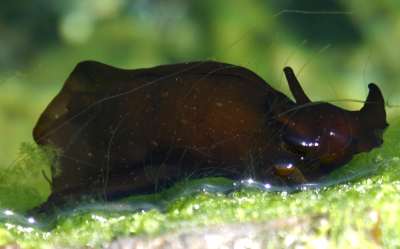
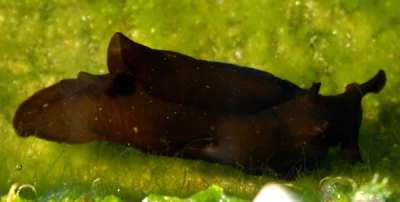
Dear Bill
Thank you very much for your answer [#14485].
What amazing sea creatures they are ... they remind me of a Dugong or a Hippo the way they graze on the sea grass. You mentioned one of the animals in my photos may have been Aplysia juliana. Are the attached photos of Aplysia juliana?
They are also found in the Kiama Rock saltwater swimming pool. The pool seems to be a perfect ecosystem. [Kiama on the south coast of New South Wales, eastern Australia].
Thanks again
Francis
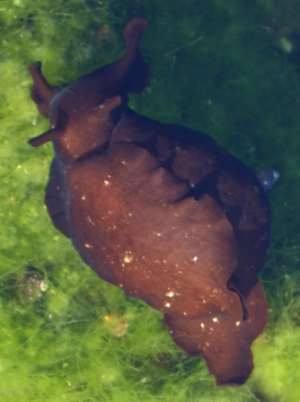
Dear Francis,
Yes these are Aplysia juliana. The brown bodies with whitish patches, is typical of one colour form of the species, as is the way the parapodia are joined quite high at the back as you can see in your upper photo. The artificial rock swimming pools built many years ago up and down the coast of New South Wales have proved a very favourable spot for Sea Hares. Unfortunately some local authorities are concerned that they will be sued if someone slips on a patch of algae, so they regularly clean the pools and their surrounds with chemicals - killing the animal life in the process.
Best wishes,
Bill Rudman
Aplysia juliana being eaten by crab
June 7, 2005
From: Dong Bum Koh
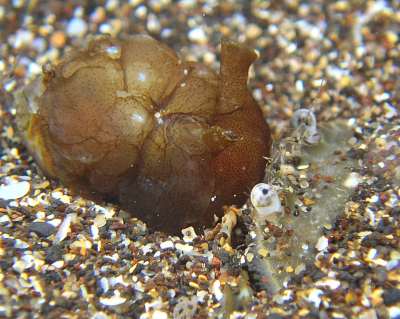
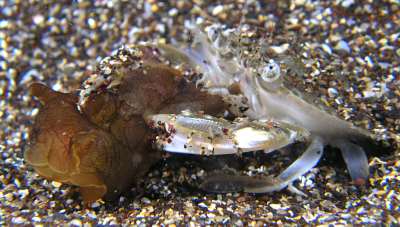
Dear Bill,
Here are a set of photos for your Forum showing living Aplysia sp. was eaten by Crab. Could you help ID this Seahare?
Locality: Hwa Soon. Jeju island, South Korea. Depth: 4 m. 19 Dec. 2004. Sandy bottom. Photographer: Byung Ro Yun
Best regards,
Dong Bum Koh
drkoh@seasee.co.kr
D. B. Koh, 2005 (Jun 7) Aplysia juliana being eaten by crab. [Message in] Sea Slug Forum. Australian Museum, Sydney. Available from http://www.seaslugforum.net/find/13926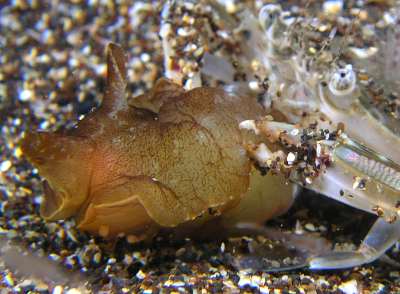
Dear Koh,
Thanks for this interesting predation record. Perhaps it was a crab that attacked the animals in your other message [#13918]. Concerning the identity of this Sea Hare. It is hard to be sure, but I suspect it is Aplysia juliana. Apart from general colour similarities, a Sea Hare being attacked like this would usually squirt out some red-purple ink. Aplysia juliana is one of the few species which doesn't produce purple ink, so that adds to the probability that it is that species.
Best wishes,
Bill Rudman
Aplysia juliana laying eggs
May 25, 2005
From: Dong Bum Koh
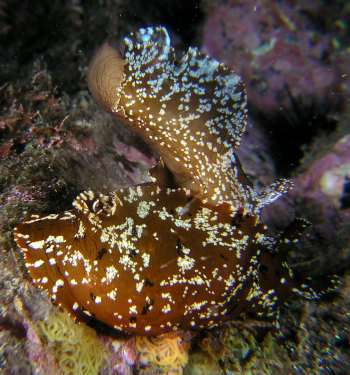
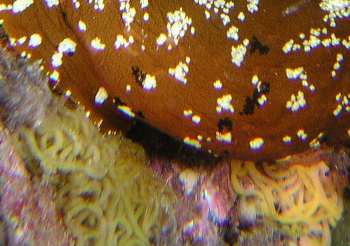
Dear Bill,
Here is a photo of what I think is Aplysia juliana with its eggs for the Sea Slug Forum.
Locality: Hwa Soon, Jeju Is, Sth Korea. Depth: 4 m. Length: 90 mm. 10 Oct. 2004. Rocky bottom. Photographer: Sang Yual Shin
Best regards,
Dong Bum Koh
drkoh@seasee.co.kr
D. B. Koh, 2005 (May 25) Aplysia juliana laying eggs. [Message in] Sea Slug Forum. Australian Museum, Sydney. Available from http://www.seaslugforum.net/find/13799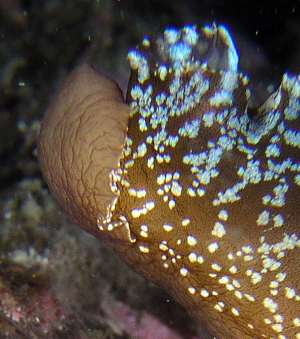
Dear Koh,
This is probably what Baba (1949: Pl 3, fig 11) identified as Aplysia sibogae Bergh. However I agree with you that it is most probably a colour form of A. juliana. Although the animal in the photo alongside my comment seems to be a bit damaged, it does show the pad-like muscle which A. juliana has at the posterior end of the foot. It uses this to form a 'sucker' when moving. Rather than crawling alongs smoothly like most Sea Hares, it often moves by attaching the posterior part of its foot, and then stretching the rest of the body forward, like some looping caterpillar. I have described a similar movement in Dolabrifera dolabrifera [see message #9789].
Best wishes,
Bill Rudman
Aplysia juliana - breeding in Tasmania
November 16, 2003
From: Melanie Godfrey-Smith
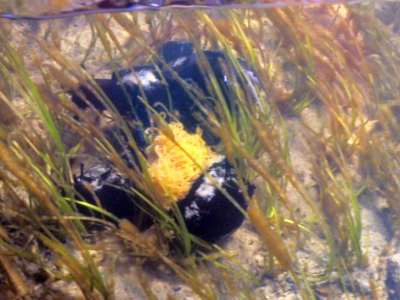
Hi there. Please pass this on to anyone who may be interested.
In the last three weeks, seemingly from nowhere, we have many hundred thousand of these at Henderson Lagoon, Falmouth, Tasmania [Australia]. Previously Asterias amurensis and also Carcinus maenas have been studied in this lagoon as well.
They are solid coloured and appear to be black, but could be dark brown. Very few have 2 or 3 small white or grey/white stripes. There are hundreds of thousands and they "carpet" the lagoon for kilometres in all directions from the middle. Within the last 4 days they have started "nesting" (if that is the right word) and about 20% seem to be producing eggs. (per photos) Some appear to be dying this week, and many are reaching the estuary and floating out to sea on the tide, but there are many, many thousands still here.
I chose the worst possible day to try to capture an image and will endeavor to get a better image tomorrow or the next day.
I hope this is of interest.
Melanie Godfrey-Smith
falmouth@bigpond.com
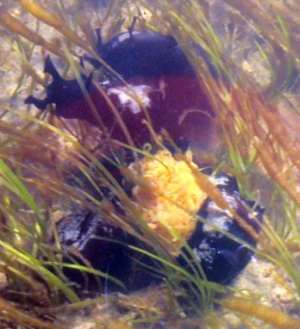
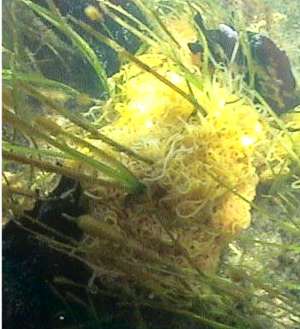
Dear Melanie,
You can rest easy. This is not another northern hemisphere invader like the unwelcome crab [Carcinus maenas] and starfish [Asterias amurensis] you mention. Sea Hares often suddenly seem to appear like this from nowhere in huge numbers to breed and die. Their appearance can cause locals, such as you, to worry about foreign invaders and their deaths can cause others to worry about pollution. Have a look at the page on Mass Mortality for futher information on this topic.
I am pretty sure your animal is Aplysia juliana. It often occurs in large breeding aggregations like this in early spring, but not always in the same locality. In Sydney it usually occurs a couple of months earlier - say September - but by chance I got an inquiry yesterday from someone who had just seen large numbers laying eggs in the Parramatta River, the large estuarine extension of Sydney Harbour.
Best wishes
Bill Rudman
Aplysia juliana - breeding in NZ
August 16, 2003
From: Paul Furneaux
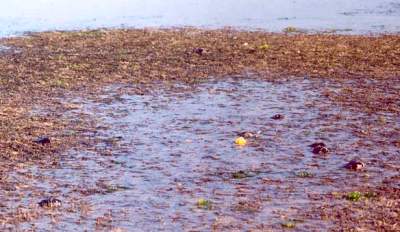
Dear Bill,
I've been monitoring the activity of a group of Aplysia juliana that I first noticed on July 14th this year, and they have been very busy mating and laying egg-masses for the past 4 weeks and as yet show no signs of slowing down. The area is the same one that I have been working in for the past several months in Tauranga Harbour, New Zealand, and the Aplysia have confined themselves to a particular area of about 140m by 110m, which is very close to the low tide mark and has some areas of Zostera "banks" that dry off briefly at low tide and other areas that retain 5-10cm of water at low tide. The whole area is covered in the sea grass Zostera and also has a good supply of the green alga Ulva.
The Aplysia seemed to be focused on breeding but at low tide when I visit them they are "resting", often out of the water, sometimes covered in Ulva, sometimes partly buried in mud, and seem uninterested in moving even when placed in the water.The evidence of their mating activity is everywhere to see in the form of their bright yellow egg masses which are stuck to Zostera or Ulva. Over the past 4 weeks I have counted both the Aplysia numbers and the egg-mass numbers and the interesting thing is that although the Aplysia numbers fluctuate between 76 to 217 animals, the egg-mass numbers have never risen above about 150, despite the best efforts of the Aplysia, whose daily efforts in egg-mass production are quite extraordinary so I assume that the egg-masses are being predated on but by what I am unable to figure out. There are many candidates.
Anyway, they are of great interest to me and I've decided to keep a tiny sample of their eggs in a tank to follow proceedings more closely, I'll keep you posted on progress.
Regards,
Paul Furneaux.
P.Furneaux@xtra.co.nz
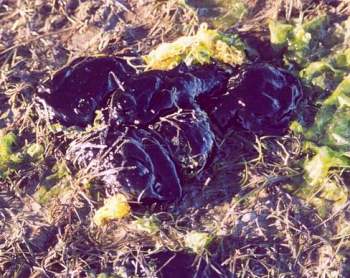
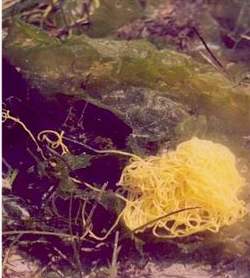
Thanks Paul,
It would certainly be interesting to know what is eating the egg masses as it is thought that Sea Hare eggs could be protected from predation, by various chemicals, perhaps derived from their plant food.
Best wishes,
Bill Rudman
Aplysia juliana from New Zealand
June 30, 2003
From: Paul Furneaux
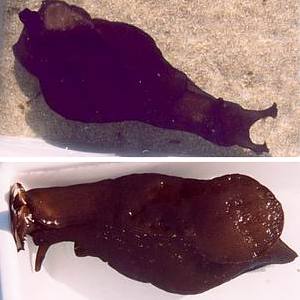
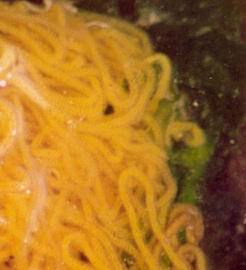
Hi Bill,
While I was searching at night unsuccessfully) for some active Bulla quoyii (in Tauranga Harbour, New Zealand) I came across a large (approx 20cm) example of what I have worked out is Aplysia juliana. The information on the Forum was very helpful with this identification. This animal did not release the "ink" described for A. dactylomela and its movement followed the "leechlike" pattern described for A. juliana, and you may be able to see the sucker-like part of the foot in the ventral view. Because of its uniform, dark, olive green colour I found it difficult to obtain a good photo (I kept it in a bucket of aerated sea-water until the next day to photograph it in sunlight, then released it later that day- 9.06.03)
It was feeding on Ulva and once I placed it in the bucket the large volume of faeces soon became apparent, quite extraordinary. Also, a few days later (14.06.03) when I was out on the flats during daytime, I photographed an unusual looking egg mass string - bright yellow and looking like someone's pile of "instant noodles". From what I've read on the Forum this could be the egg mass of Aplysia juliana, and I would appreciate it if you could confirm this for me Bill. I've included the photo that I took.
Bulla quoyii remains a real challenge but I hope to be able to send you something of this species before too long.
Regards,
Paul Furneaux.
P.Furneaux@xtra.co.nz
Furneaux, P., 2003 (Jun 30) Aplysia juliana from New Zealand. [Message in] Sea Slug Forum. Australian Museum, Sydney. Available from http://www.seaslugforum.net/find/10355Dear Paul,
Yes this is Aplysia juliana. It was for many years called Aplysia brunnea or Aplysia nigra brunnea in New Zealand. It feeds mainly on green algae such as Ulva or Enteromorpha which could explain why it doesn't produce red or purple ink as the ink pigment seems to be derived from pigments found in red algae.
The egg ribbon is definitely that of a Sea Hare, but I can't say definitely if it that of Aplysia juliana, although that is the most likely identification. Good luck with your Bulla search. Although they are sometimes present in large numbers, I have never been able to find them when I wanted one.
Cheers
Bill Rudman
Sea hares, mating pair - from Sydney
November 30, 2002
From: Iain Whyte
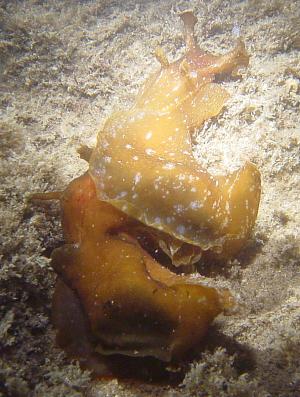
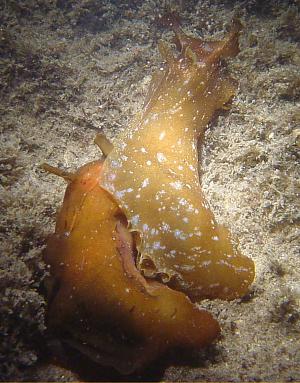
Hi Bill,
Thought you might be interested in photo's of a pair of mating (well, I think so?) Sea Hares from Sydney. Photographed at night in Gordon's Bay, Sydney, in about 8 metres of water [NSW, Australia].
Regards,
Iain Whyte
q@thewell.au.com
Whyte, I., 2002 (Nov 30) Sea hares, mating pair - from Sydney. [Message in] Sea Slug Forum. Australian Museum, Sydney. Available from http://www.seaslugforum.net/find/8548Thanks Iain,
I guess you photographed these two recently. Yes they are mating. Although you can find mating pairs at most times of the year, except mid-winter, spring and autumn are the main mating times. This is a species called Aplysia juliana.
Best wishes,
Bill Rudman
Aplysia juliana from Korea
June 19, 2002
From: Ronald Noseworthy
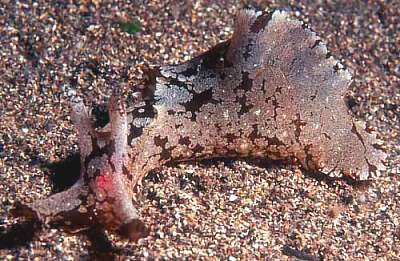
Dear Bill,
Thanks for your earlier comments. Here is a photo of A. juliana from Chejudo, Korea, photographed by Dr. Koh. I hope you can use it.
Sogwipo, Cheju Island, South Korea; depth of
20 meters; March, 2001. Photo: Dong Bum, Koh.
All the best!
Ron
globalmark@canada.com
Noseworthy, R., 2002 (Jun 19) Aplysia juliana from Korea. [Message in] Sea Slug Forum. Australian Museum, Sydney. Available from http://www.seaslugforum.net/find/7286Thanks Ron,
This is the same colour pattern that is illustrated in Okutani, [Marine Mollusks in Japan, 2000] from Japan. A. juliana is a widespread species and ranges in colour from black to brown with pale mottlings. I have never seen this pale whitish colour pattern with a few darker brown patches before. It will be interesting to see in your study just how variable this colour form is.
Best wishes,
Bill Rudman
Re: Aplysia from Taiwan
April 16, 2001
From: Tony Wright
Hi Bill,
The beast was 6-10 cm long. Also, not an ink producer, I wondered about this. Now all is clear!
Cheers,
Tony
a.wright@uni-bonn.de
Wright, A.D., 2001 (Apr 16) Re: Aplysia from Taiwan. [Message in] Sea Slug Forum. Australian Museum, Sydney. Available from http://www.seaslugforum.net/find/4191Aplysia from Taiwan
April 14, 2001
From: Tony Wright
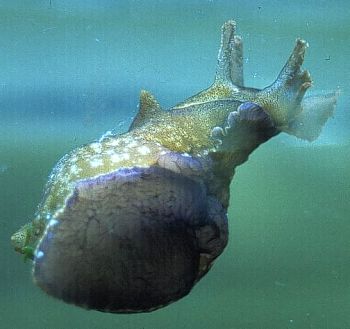
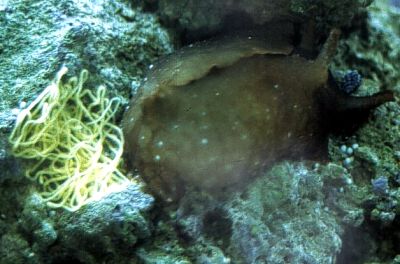
Hi Bill,
Attached are pictures of a sea hare I collected in Taiwan. Note egg mass in lower photo. Can you give it a name?
Many thanks,
Tony
a.wright@uni-bonn.de
Wright, A.D., 2001 (Apr 14) Aplysia from Taiwan. [Message in] Sea Slug Forum. Australian Museum, Sydney. Available from http://www.seaslugforum.net/find/4180Dear Tony,
It looks like Aplysia juliana, which can grow to 30cm in length. Baba (1937) records two species from Japan (Aplysia sibogae Bergh, 1905 and Aplysia kurodai Baba, 1937) both of which could be colour forms of A. juliana. Both were reported to secrete a white fluid from the opaline gland which is usually only obvious in species like A. juliana which do not secrete purple ink as well. Another characteristic of A. juliana is the way the rear part of the foot forms a sucker which can clearly be seen in your upper photo
I would be interested to know whether it produced any Purple ink when you handled it. If so it wasn't A. juliana. Aplysia juliana is very variable in colour, ranging from a uniform black to light brown with whitish patches. I would also be interested in some indication of its size.
Reference:
• Baba, K., (1937) Opisthobranchia of Japan (I). Journal of the Department of Agriculture, Kyushu Imperial University, 5(4): 195-236. (Pl.4)
Best wishes,
Bill Rudman
Sea Slug feeding and babies
February 16, 2000
From: Andrew McDonald
Hello Dr Rudman,
We have three dark brown with white spots sea slugs ranging from 50 to 150 millimetres long in an unheated room temperature salt water tank. They have large vertical fan like wings on each side which they like to flare and use to float and drift in the air bubbles from our air pump and under gravel filter. The sea slugs share the tank with about a dozen black fish (silver with zebra stripes), three lizard fish (speckled green and white bottom dwelling hunters) and a dozen prawns.
We have been feeding the sea slugs light green sea lettuce which they ravenously devour with their vertical mouths. I would be grateful if you could advise me on whether there is anything else they will eat and how often should they be fed?
So content are our sea slugs that they have produced six masses of strings of yellow eggs which are slowly turning pink. Could you please tell me if this colour change is good and how does one care for sea slug babies?
Locality: Victoria / New South Wales border, East Coast of Australia
Many Thanks
Andrew McDonald
amcdonald@start.com.au
McDonald, A., 2000 (Feb 16) Sea Slug feeding and babies. [Message in] Sea Slug Forum. Australian Museum, Sydney. Available from http://www.seaslugforum.net/find/1910Dear Andrew,
I am pretty sure that your sea slugs are Sea Hares. If you go to that page you will find plenty of information on them and links to other pages on the Forum with stuff on Sea Hares.
Some species flap their the wing-like 'parapodia' to swim, but from your description, your animals are really just drifting in the currents. I suspect the species you have is Aplysia juliana which ranges in colour from pale brown to black and often has whitish patches on the body. Most sea hares produce a purple ink if they are disturbed. A. juliana is one of the few species that does not, so if your animals do produce purple ink let me know and I'll rethink my identification.
On food. Most species change their algal food during their life cycle. Your animals are apparently thriving Ulva - the Green Sea Lettuce, so I would leave them on that as other algae often foul aquarium water by excreting toxic chemicals. If you run out of sea lettuce one correspondent to the Forum said they used ordinary lettuce to feed sea hares.
The change in colour of the eggs (or rather the developing larvae/embryo) is quite normal. You will know when the larvae hatch because you will have swarms of tiny veliger larvae swimming in the aquarium and probably getting stuck in the surface film. Without special equipment it is unlikely that you can keep the free swimming larvae alive and feeding in aquarium conditions. How long will your adults live? In the wild they are only likely to survive a few months and definitely leass than a year. In aquaria things tend to live a bit longer but if they do die it's probably because of their age not the way you are looking after them.
Best wishes,
Bill Rudman.
